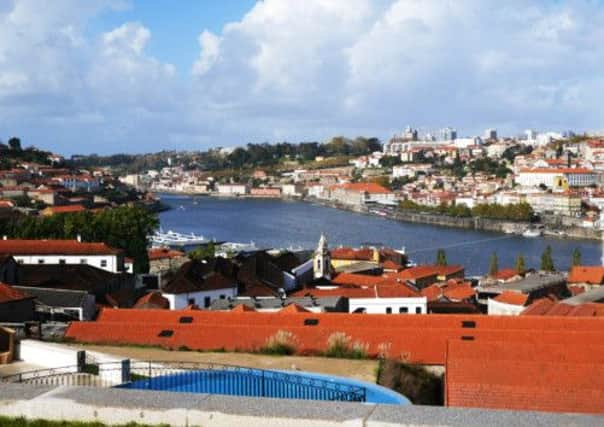A hoard of treasures


From its birth in northern Spain to Portugal’s second city, the “river of gold” – Duero in Spanish and Douro in Portuguese – offers some of the world’s most spectacular scenery. Close to its banks, the visitor can discover ancient art, Baroque houses, magnificent churches and the source of a great wine.
Fly to Valladolid, which was briefly the capital of Spain, and stay outside Salamanca at Hacienda Zorita. Today a wine hotel (as it lies amid vineyards), the 22 rooms were formerly a 14th-century Dominican monastery. Reputably this is where Christopher Columbus consulted the mathematicians in 1486 before his voyage to America.
Advertisement
Hide AdAdvertisement
Hide AdZorita, which hosts a luxurious spa and other modern facilities, prides itself on offering fine regional cuisine which goes well with Durius wines. The breakfast restaurant lies over a fast-flowing river with minnows leaping forth.
Salamanca has a university founded in the 13th-century with a noted library housing over 2,800 manuscripts. On the sandstone walls, do not miss either the names of distinguished students, painted in blood, or the carved frog. If you spot the latter without help, local legend says you will receive good luck and marriage within a year.
South-west lies the walled border town of Ciudad Rodrigo, where the British are warmly welcomed to this day as Wellington defeated the French there in 1812 when it was besieged as part of the Peninsular War.
The fine cathedral of Santa Maria, founded in 1175, is well worth viewing and then enjoy lunch at the parador (Enrique II), a 14th century castle built into the town’s western walls.
Advertisement
Hide AdAdvertisement
Hide AdAfter crossing into Portugal, take the N102 north towards the Douro. On the right, set among almond trees and olive groves, are the villages of Muxagata and Vila Nova de Foz Coa from where extraordinary Paleolithic rock carvings can be found. Dating from 22,000-10,000BC, see muzzled horses, aurochs (wild cattle), deer and fish depicted in the vertical schist.
The Douro has now carved a dramatic, rugged gorge on whose banks sporadically appear steep terraced vineyards. The work is back-breaking and yet the wine made, Port and more recently Douro reds and whites, is so appealing.
Enjoy locally made rich reds like Cristiano van Zeller’s Quinta Vale Dona Maria, Niepoort’s Batuta and Olazabal’s Quinta do Vale Meao with paio and salpicao sausages, broad bean soup and hard Cabra Transmontano and Terrincho cheeses with marmelada (quince jam).
Port used to be taken down the river in flat-bottomed boats, rabelos, but this stopped when dams were built to provide hydroelectric power. Don’t miss the Carrapatelo dam, Europe’s deepest navigable lock. Near Vila Real is the Baroque manor house of Mateus, famous for the pink wine of the same name but made elsewhere. Its tea salon and noted 18th century paintings, as well as romantic gardens, are worth a detour.
Advertisement
Hide AdAdvertisement
Hide AdLamego lies just south of the Douro. The town hosted Portugal’s first Parliament in 1143. Today it is largely visited for a beautifully sited chapel, Nossa Senhora dos Remedios, which should first be seen from the foot, looking up at 686 steps and nine terraces, decorated with tiles. Do not miss Grao Vasco’s altar panels and fine 16th century Flemish tapestries housed in the local museum, which was formerly the bishops’ palace.
Along with Chaves, Lamego offers arguably the finest smoked ham (presunto) where whole legs are cured for up to a year, and often served with melon. Try also caldo verde which is delicious kale broth, thickened with cornmeal bread – a lunchtime feast!
For Baroque elegance, Solar de Rede manor house in nearby Mesao Frio offers spectacular views of the Douro. Today it is a 29 room hotel with tennis court, swimming pool and even its own vineyard. Its restaurant is one of the finest in the region.
Head north-west to Guimaraes where Portugal’s first king came from almost 900 years ago. With its narrow Medieval streets, Sao Miguel castle built to deter Moors and Normans, fine museums and churches, a strong music tradition and renovated main square, it is no surprise the city was designated EU “Capital of Culture” last year.
Advertisement
Hide AdAdvertisement
Hide AdFor shoppers, do not miss nearby Barcelos where each Thursday the town square sees the largest open-air market in Europe. It is a riot of colour.
Porto reminds many of Yorkshire with its grand 18th century buildings. That is hardly surprising as the noted York architect John Carr (1723-1807) designed several. In addition to Harewood House and York’s Crown Court (then the Assize courts), Carr was commissioned for both Santo Antonio Hospital and the elegant Factory House in Porto and his Palladian touch is evident today.
Linger among the warren of narrow streets that form the Ribeira riverside lined with arcaded markets, see the fine 17th century gilded woodwork in Santa Clara church, Bolsa palace (old stock exchange) with its glittering Arab room and then cross to the southern bank of the Douro.
Vila Nova de Gaia is where the Port lodges age the world’s famous fortified wine. Croft is named after Thomas Croft, a York wine merchant who went out in 1736. Stay and dine in arguably Portugal’s finest hotel, The Yeatman. With 82 bedrooms, each with a balcony enjoying a stunning view, the Michelin-starred restaurant sets a new high level in Portugal.
Advertisement
Hide AdAdvertisement
Hide AdIf time is too limited to explore the Douro, at least take the little train from Porto to Pinhao. Both stations are decorated with wonderful tiles, in Pinhao’s case depicting folk culture. The railway was completed in 1887 and allows fantastic views of one of the greatest but still unexplored gorges.
Getting there
Direct flights to Valladolid from Heathrow (Iberia) or Stansted (Ryanair). From Porto, easyJet and TAP fly to Gatwick and Ryanair to Stansted.
For accommodation: Hacienda Zorita 0034923 129 400, Enrique II 0034923 460150, Solar de Rede 00351 254 890130, The Yeatman 00351 220 133100.